So fascist, communal, divisive and fundamentalist forces of Jammu have finally succeeded in getting the whole issue of Amarnath Forest Land Row camouflauged and sabotaged to their favour under the garb of Nationalism and Patriotism. Once again, following the age-old maxim of "give the dog a bad name and kill him", state government has inflicted most horrendous crimes against humanity in Kashmir after labelling the unarmed, protesting civilians as secessionists.
Now it is time for the separatist leaders of Kashmir to shun their rhyming rhetoric of allowing and supporting the Amarnath pilgrimage in its present tone and tenure. It is time to get to terms and call a spade a spade. People across India have been trumpeting the so-called income that Kashmiris purportedly have been generating from the Yatra. So much so that Ram Vils Paswan went to the extent of saying that if left to Kashmiris, they would very well prefer the Yatra to continue for the entire year owing to the income they generate from Amarnath yatris.
This is a part of large scale misinformation campaign and false propoganda unleashed by right wing hindu fundamentalists and duly fostered by the Indian media. The fact of the matter is that yatris come in groups with their tour packages finalized at their native places with their local operators. They go back in same vehicles in which they come. Food outlets where they eat are mostly Vaishnovi dhabas owned by their fellow brothren from outside the state. They do all the shopping at Jammu again from their compatriots belonging either to Jammu or outside the state. Due to their plenty of hatred against Kashmiris they see to it that Kashmiris don't gain much from their influx into the valley. Only people supposedly to gain from yatra are the ponneywalas of Pahalgam who earn only coins and not notes from them out of their nerve-wrecking and spine chilling hard labour. Are Kashmiris so hapless to bow and surrender their honour and prestige for the sake of few morsels thrown to poor ponneywalas and the like, of course not.
It is high time we start talking tough about the large scale devastation and destruction that lakhs of pilgrims cause to our ecology in Amarnath region. Several national and international environmental agencies have warned that large scale movement of pilgrims in a purely ecological and environmentally sensitive area will wreck havock to the glaciers there which are diminishing very fast bringing lot of damage to our climate and environment. No wonder over the past few years, Kashmir has been witnessing snow psunamies, floods and inundating rainfall. Now in comparison to the income poor Kashmiris make out of Yatra, can there be any match for the damage it causes to our life and property in addition to our serene forests. Imagine how much shit and garbage might have been thrown by over five lakh yatris into lidder river and the pristine glaciers at an altitde of over 3500 feet. When BJP government in Uttranchal restricted number of pilgrims visiting Gomuch Temple to a meagre 150 per day to save their Gangotri and for other environmental reasons, nobody resisted this move. Why can't we in Kashmir demand restriction of the daily and total number of pilgrims visiting Amarnath on the similar grounds besides reducing the total duration of yatra to 15 days.
After all it is the bearer of Chardhi Mubarak (Holy mace of lord shiva) namely Mahant Deependra Giri of Dashnami akhada who has time and again voiced concern over the fast deteriorating religious sentiments of the amarnath yatra. He has several times made it clear that this yatra holds religious significance only for a period of fifteen days upto shrawan purnima and that beyond these fifteen days yatra holds no meaning at all. Why his voice is being curbed under the garb of communal frenzy and fascist passions of hindu fundamentalists. It is time we should sound alarm bells about our environment and demand restricting daily rush of yatris to a few hundred of them and reducing its total duration to only fifteen days. We should stop thriving on this dangerous tradition and voice our concerns loud and clear without any fear. Hope our leaders learn some lessons from the aggressive tactics of Jammu Sangarsh Samiti and take some cue from them as to how to protect our interests against all odds. It is time to stop being remorseful, defensive and humble because we have not achieved anything out of that except curfew and killings. It is time to pursue your genuine goals aggressively and without any regretful attitude.
Sunday, August 31, 2008
Subscribe to:
Post Comments (Atom)














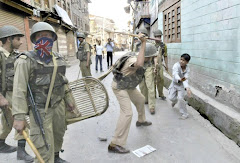





















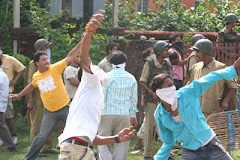

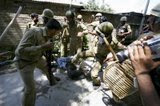




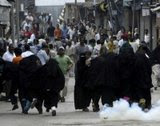







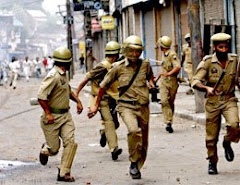
Ecologists warn of catastrophe
ReplyDeleteCourtesy: Daily Rising Kashmir
Thursday, 26 June 2008
Huge pilgrim presence around glaciers can spell doom
Mehboob Jeelani
Srinagar, June 25: Blaming the state government for huge pilgrim presence in ecologically-sensitive areas of Baltal and Sangam, glaciologists on Wednesday warned of a catastrophe. The glacier experts said that the presence of over 2,83,000 pilgrims at a height of over 12,500 feet above the sea level in Sangam and Baltal has started the melting of glaciers in the region.
This is likely to increase temperatures which may raise the level of precipitation; the glaciologists said.
Reputed Indian glaciologist, Syed Iqbal Hasnain, who chairs the Glacier and Climate Change Commission, Government
of Sikkim, said. It is the government's responsibility to keep the safety of glaciers into consideration before
allowing 2,83,000 pilgrims to Sangam.The melting of glaciers is obvious when there is human intervention of such intensity, he said, adding that the body
temperature of 2,83,000 pilgrims, generation of heat due to cooking and other purposes would definitely increase the overall temperature in the vicinity of Sangam glacier.The glaciers may further deteriorate and lead to severe environmental crisis,said Hasnain.About the effect of melting of glaciers, he said that the increase in atmospheric temperatures, longer droughts and side-effects of both are likely to bring about a substantial reduction in crop yield in the coming decades. A geology expert Muhammed Ismail said that the rise in temperatures due to melting of glaciers has direct effects on
mortality - temperature dip in winters increase deaths in cold and higher temperatures in summer increase heat-related deaths.
The mortality rate is likely to increase in the hot temprature zone of Jammu in summers and in Kashmir during winters,said Ismail.
He also warned that a number of species would be wiped off besides wilting of the serene beauty of the region.He said: Extreme temperature increases the deaths of people due to heart problems. These people are vulnerable because one's cardiovascular system must work harder to keep the body cool during hot weather. Respiratory problems increase in such weather,he said.
They must restrict the number of yatris:
ReplyDeleteCourtesy: Daily Greater Kashmir dt. Sep 11th, 2008
Prof. Lawrence G. Gundersen, Professor of History and Political Science, Jackson State University, USA is an Environmental Historian specializing in Agricultural History and World Crop Production. He was part of a unique two day expedition of scientists to the Lidder valley to study the fast melting Kolahoi glacier, a major source of water to the entire valley. Prof Lawrence G. Gundersen in an exclusive interview with Majid Maqbool talks about the impact of melting away of Kolahoi glacier on the rice production of Islamabad. More the number of yatris, more the danger of losing the beauty of the valley. If glaciers continue to melt, there will be no rice production. He stresses the need to setup sustainable toilets by the central government every quarter of a mile all the way to the Amarnath cave so as to lessen the environmental cost of the annual Amarnath yatra.
You were part of the two day expedition to study the fast melting Kolahoi glacier in Lidder valley. What are the environmental issues related to Amarnath yatra?
We founded an association called Association of South Asian Environmental Historians (ASAEH) in 2005 at Jarapur University at west Bengal.
I have two issues with regard to glacier mounts and yatras. First with regards to yatras, as a historian we look at things as they occur in time. 40 years ago how many sadhus were coming up to the Amarnath cave? When you have 200 sadhus defecating along the way on the sides—that’s not going to be an environmental problem. But when you have 20,000 or 2 lakh people defecating and urinating in the open, this causes diseases and then it gets into the water table and causes problems in the ground water.
As an expert on crop production how will the melting away of Kolahoi glacier in Lidder valley affect rice production?
One of the major issues about glaciers— which was not addressed— is that around Islamabad you have development of rice fields. You have a huge number of rice fields and its growing. And now the University of Kashmir’s agricultural college has developed a new rice that grows at even higher altitude. Rice is a water intensive crop. And you can have a water intensive crop as long as you have plenty of glacier melt. But if your glaciers are simply melting away, and 10 years from now if there is no glacier, you simply can’t form rice. And then all of these people associated with rice production will be displaced because you have to go for other crops like corn or wheat. So as an Environmental Historian there has been a shift over time because there is no available water.
So if glaciers melt, there will be no rice production in Islamabad because the crop is not dependent on rainfall but directly dependent on river water. And as you know Dal lake has already shrunk by some 20 kilometers, and this is because of bleeding off of irrigation with the water intensive crop like rice. Now there are some less intensive crops like corn or wheat which are sustainable but rice production is not going to be sustainable when glaciers are gone. Then you are dependent on rainfall because you don’t have patch bases to do this. And then what will happen further downstream is that India already has a shortage of water period and every body knows that. And this may be one of the reasons why India is so adamant about holding on to Jammu and Kashmir— because of its water resources. And downstream places like Gujarat, Rajasthan, Haryana to UP and west Bengal—they are all suffering from water shortage.
So the melting of Kolahoi glacier is alarming as it will affect crop production in Kashmir?
Yes, it’s very alarming because the Kolahoi glacier melt supplies a certain percentage of the annual water for people. And this is cleaner water, fresh water, and as good as you can get. The rainfall water has a tendency to collect the particulate matter that comes out of clouds, and as it comes down, it’s dropping acid rain, bringing down Sulphur particles and carbon monoxide particles. So that comes down and it contaminates the soil with the rainfall. So what ends up happening in these catch-basins and in these ponds where you try to reserve water is that they become not much poisonous but nothing can live in that water.
What solution would you suggest to lessen the environmental impact of Amarnath yatra?
They should build environment friendly toilets along the way about every quarter of a mile. And this will work. But this is not done at present; they are defecating in the open. It’s a minefield all the way up and a serious issue that is affecting the environment.
Here is the other problem: the Indian government said they have put in portable toilets. I have seen the Indian government’s portable toilets. They fill up, and once the toilets fill up, what do they do? They unplug it and they just let it run out. So it is useless because they are temporary solutions. What I am talking about is a sustainable toilet that the farmers and the local shepherds up in the Lidder valley can actually use for their animals and for their local crops. And this is also environmentally sustainable. So sustainable facilities along the way is the solution, not portable toilets which are not going to work.
And should the number of yatries be regulated to lessen the human intervention factor on the environment of Lidder valley?
Yes, the administration should not let 2 lakh people go up there every year. I know the central government will say and BJP will support that their holy men have to go up there, and they make it a political issue. But this shouldn’t be a made a political issue. This is an environmental issue, not a political issue. Now if the central government wants to come in and built these sustainable toilets every quarter of a mile all the way to the Amarnath cave, well, that is good. Let the central government come in and fund this. The state government can not afford to do this.
So something has to be done to stop this glacier from melting because there is a global factor plus you have these clouds hanging— which means Himalaya glaciers will be melting twice as fast as other glaciers in the world.